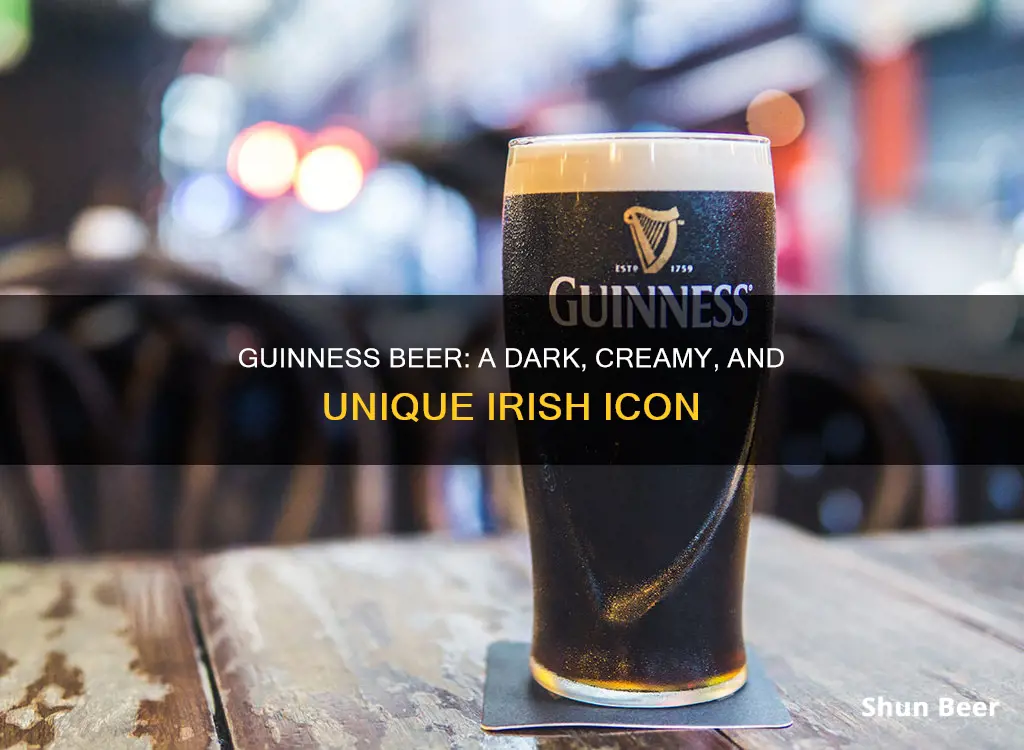
Guinness is a traditional Irish stout beer with a distinctive reddish-black colour and a thick, creamy head. It has a rich, caramelised flavour and is made from barley, hops, water and a specific strain of ale yeast. The beer is named after Arthur Guinness, who founded the brewery in Dublin, Ireland, in 1759. It is now one of the most successful beer brands in the world, sold in over 100 countries and brewed in almost 50.
Guinness has a number of unique characteristics. It is the first beer to use nitrogen, which gives it a smooth, velvety texture and a creamy head. It also has to be poured in a specific way, with a two-part pour, to create the ideal head thickness. The beer is surprisingly low in alcohol content and calories compared to other lighter beers.
The brand has a long and fascinating history, including a 9,000-year lease signed by Arthur Guinness, a short-lived holiday in honour of its founder, and a famous advertising campaign claiming Guinness is good for you.
What You'll Learn
- The history of Guinness, from its beginnings in Dublin in 1759 to its present-day popularity
- The unique flavour and appearance of Guinness, derived from roasted barley
- The health benefits of Guinness, including antioxidants and folates
- The art of pouring the perfect pint of Guinness, including the two-part pour
- The global reach of Guinness, with a focus on its popularity in Africa and the UK

The history of Guinness, from its beginnings in Dublin in 1759 to its present-day popularity
On 31 December 1759, Arthur Guinness signed a 9,000-year lease on St. James's Gate Brewery in Dublin, Ireland, and started brewing ales. Ten years later, Guinness exported his ale to Great Britain for the first time. In 1778, he started selling the dark beer porter, and in the 1840s, the first Guinness beers to use the term "stout" were Single Stout and Double Stout.
By the early 1800s, Guinness had found an export market, and by the 1860s, it had grown from a local favourite to a global brand, with barrels of its beer being shipped around the world. In October 1886, Guinness became a public company, and by 1900, the brewery was operating unparalleled welfare schemes for its 5,000 employees.
In 1914, over 800 employees at the St. James Brewery were encouraged to join the British forces during World War I. Of the 800 employees who fought, 103 did not return. During World War II, the demand for Guinness among the British was so high that the UK lifted commerce restrictions imposed in 1941 to force Ireland into supporting the Allied Powers.
In 1932, at the beginning of the Anglo-Irish trade war, the company moved its headquarters to London. In 1959, Guinness began using nitrogen, which changed the texture and flavour of the beer, giving it a "creamier" and "smoother" consistency.
In 1986, Guinness acquired The Distillers Company, which led to a scandal and criminal trial concerning the artificial inflation of the Guinness share price. In 1997, Guinness merged with Grand Metropolitan to form Diageo plc, a multinational alcoholic drinks producer based in London.
Guinness has a significant share of the African beer market, where it has been sold since 1827. Three of the five Guinness-owned breweries worldwide are located in Africa, and about 40 percent of worldwide total Guinness volume is brewed and sold on the continent.
Today, Guinness is one of the most successful alcohol brands worldwide, brewed in almost 50 countries and available in over 120. It is the best-selling alcoholic drink in Ireland, and the most popular draught beer in the United Kingdom.
The Evolution of Guinness Beer: A Historical Perspective
You may want to see also

The unique flavour and appearance of Guinness, derived from roasted barley
The flavour and appearance of Guinness are unique, and this is largely due to the roasted barley used in its production.
Guinness is a traditional Irish stout beer, and its distinctive dark colour and caramelised flavour are a result of barley that has been roasted but not malted. The barley grains are roasted, developing a deep, dark hue that is then transferred to the beer during the brewing process. This process also gives Guinness its intense roasted notes and bitter aromas, reminiscent of strong black coffee or Italian espresso.
The use of roasted barley is indispensable for creating the characteristic flavour and appearance of Irish and Scottish stout beers, as well as intensifying the colour and aroma of dark ales, porters, and dark beers.
Guinness has a long history of innovation in its brewing process, dating back to the late 1790s. Over time, they have experimented with different ingredients and techniques to create their unique beer. In the early 1800s, for example, they started using drum-roasted black malt instead of brown malt, which contributed to the distinct dark colour of Guinness.
In the mid-20th century, Guinness introduced unmalted barley to their grist, which is now a signature of the style. This change in the brewing process further enhanced the dark colour and unique taste of Guinness.
Today, Guinness is one of the most successful beer brands worldwide, available in over 120 countries and brewed in almost 50. Its distinctive flavour, appearance, and creamy mouthfeel have made it a beloved drink for many, and it is often considered Ireland's national drink.
Guinness Beer: Healthy or Harmful?
You may want to see also

The health benefits of Guinness, including antioxidants and folates
Guinness, the famous stout beer, has long been associated with health claims, with slogans such as "Guinness is Good for You" and "Guinness for Strength" used in advertising campaigns as early as the 1920s. While it may not be as nutritious as a vegetable, stouts and beers do have some nutritional benefits. Here are the health benefits of Guinness, including antioxidants and folates:
Antioxidants and Heart Health
Guinness, made from barley, hops, and yeast, contains plant compounds called polyphenols, which act as antioxidants. These polyphenols protect the body's cells from damage caused by oxidation. Additionally, studies have shown that moderate beer consumption may be beneficial for the heart. A 2003 study found that a pint of Guinness could reduce the risk of blood clots forming in the arteries, a benefit not seen with other beers.
Folates
Guinness contains a significant amount of folate, a B vitamin necessary for making DNA and other genetic material, and for cell division. According to research by brewing expert Charles Bamforth, Guinness contains more folate than other imported beers, with stouts containing an average of 12.8 micrograms of folate, or 3.2% of the recommended daily allowance.
Other Benefits
Guinness is also a source of vitamins and minerals, including B vitamins, silicon for healthy hair, nails, and bones, and iron. It is lower in calories compared to other beers due to its slightly lower alcohol content, and it may support hormonal balance, particularly for post-menopausal women, thanks to the plant oestrogens found in hops.
While Guinness has some potential health benefits, it is important to remember that excessive alcohol consumption can have negative effects on health. Moderate consumption is generally considered safe and may offer some benefits, but heavy drinking and binge drinking are associated with health problems such as liver disease, pancreatitis, and high blood pressure.
Guinness Nitro Beers: Nitrogen-Infused Smoothness or Marketing Hype?
You may want to see also

The art of pouring the perfect pint of Guinness, including the two-part pour
The art of pouring the perfect pint of Guinness is a blend of skill, patience, tradition, and a bit of Irish magic. It is a ceremony, a sacred ritual, and an integral part of the Guinness experience, impacting everything from the taste to the presentation.
The two-part pour, also known as the double pour, is a tried-and-true, Guinness-approved method that dates back to the 1930s. It was initially used as a means of dealing with a problem that was later solved by the introduction of nitrogen to the brewing process. Today, the two-part pour remains essential because, as Colm O’Connor, a Guinness beer specialist, explains, "if we poured it in one fell swoop, the head would be too big."
- Select the right glass: a clean, dry, and cool Guinness-branded "tulip glass" with the iconic harp logo. The tulip shape is important because it allows the nitrogen bubbles in Guinness to flow down and return to the top, creating the creamy head that makes Guinness so appealing.
- Hold the glass at a 45-degree angle to the tap: Never let the tap spout touch the glass, as this will contaminate both the faucet and the glass.
- Begin the initial pour: Pull the tap handle fully forward and pour until the glass is three-quarters full (to the top of the harp logo). The first pour should take about 60-80 seconds.
- Let the pint settle: Set the glass on the counter and allow the surge to settle. The settling step is crucial as it gives time for the nitrogen bubbles to travel down the sides of the glass and up the centre, creating the distinctive two layers of Guinness. This step should take about 90 seconds to 2 minutes.
- Top off the pint: Hold the glass straight under the tap spout and gently top up the glass, being careful not to destroy the delicate bubbles. Stop pouring when the foam forms a slight dome over the top of the glass. The total head height should be between 12-18mm or 18-20mm, according to Guinness master brewer Fergal Murray.
- Present the pint: Serve the glass with the Guinness logo facing the customer. Now you have a beautifully poured pint of Guinness, ready to be savoured.
Common mistakes to avoid when pouring a Guinness include pouring too quickly, not allowing enough settling time, underfilling or overfilling the glass, and having the wrong temperature. Remember, the perfect Guinness pour requires a blend of patience and precision, honouring the rich tradition and enhancing the entire drinking experience.
Guinness Beer: Perfect Pairing Ideas for a Hearty Pint
You may want to see also

The global reach of Guinness, with a focus on its popularity in Africa and the UK
Guinness is a stout that originated in the brewery of Arthur Guinness at St. James's Gate, Dublin, Ireland, in the 18th century. It is now owned by the British-based multinational alcoholic beverage maker Diageo and is available in over 120 countries.
The United Kingdom is the largest market for Guinness, followed by Nigeria, which overtook Ireland as the second-largest Guinness market in 2014. Other African countries, such as Cameroon, Kenya, Uganda, and Namibia, also contribute significantly to Guinness sales. In fact, Africa, with its $13 billion beer market, is the biggest source of beer sales for Diageo.
The popularity of Guinness in Africa can be traced back to the colonial era when Guinness began exporting its beer along the routes of the British Empire. The beer was formulated to withstand lengthy journeys and was first consumed in Africa in 1827. As the British Empire expanded, so did the reach of Guinness, and by the mid-19th century, it had made its way to South Africa and New Zealand.
The enduring presence of Guinness in Africa can also be attributed to locally driven marketing campaigns. One of the most successful campaigns featured Michael Power, a strong journalist portrayed as an African "James Bond." This campaign played into cultural ideals of a strong African male and contributed to the perception of Guinness as a powerful drink.
In addition to its popularity in Africa and the United Kingdom, Guinness has a significant presence in other parts of the world. It is the best-selling alcoholic drink in Ireland, and Guinness & Co. Brewery makes almost €2 billion worth of beer annually. Guinness is also available in Asia, the Caribbean, and North America, with the company continuously working to expand its global reach.
Vegan Alert: Guinness Beer's Surprising Ingredient
You may want to see also
Frequently asked questions
Guinness is a traditional Irish stout beer made from barley, hops, water, and a specific strain of ale yeast. It is one of the most successful beer brands worldwide.
The deep reddish-black colour and caramelized flavour that are characteristic of Guinness come from barley that has been roasted but not malted. The dark ale is known for its dense, creamy head, which is achieved by mixing the beer with nitrogen to create smaller bubbles that result in a thicker head.
Guinness was first produced in Dublin, Ireland, at the brewery of Arthur Guinness (founded in 1759). It is one of the world's oldest continuously operating breweries. Guinness started off brewing ales but pivoted to brewing porters and stouts in the 1770s.
Guinness has implemented a very specific set of directions for pouring the perfect pint, which involves a two-part pour. With the glass at a 45-degree angle, fill the pint three-quarters of the way. Let everything settle for 119.5 seconds and then top it off by pushing the tap backward.







